How to Grow and Care for Eastern Redbud Trees: Expert Tips for Stunning Growth
- May 20, 2024
- 2 comment
Discover expert tips on how to grow and care for Eastern Redbud trees. Achieve stunning growth with our comprehensive guide. Perfect for beginners and seasoned gardeners. Eastern Redbud trees, with their vibrant blooms and heart-shaped leaves, are a stunning addition to any garden. Whether you’re a seasoned gardener or a beginner, learning how to grow and care for these beautiful trees can transform your outdoor space.
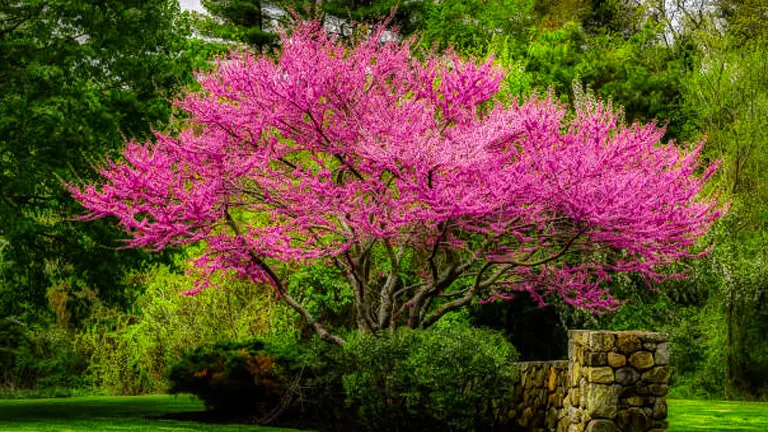
In this guide, we’ll share expert tips to help you achieve remarkable growth and ensure your Eastern Redbud thrives. From planting techniques to ongoing care, you’ll find everything you need to know to cultivate a lush and healthy tree.
Table of Contents
- Understanding Eastern Redbud Trees
- Site Selection and Planting
- Watering and Nutritional Needs
- Optimal Planting Density and Arrangement
- Pruning and Maintenance
- Advanced Pruning Techniques
- Seasonal Care
- Common Challenges and Solutions
- Benefits of Growing Eastern Redbud Trees
- Conclusion
- FAQs
Understanding Eastern Redbud Trees
Botanical Profile
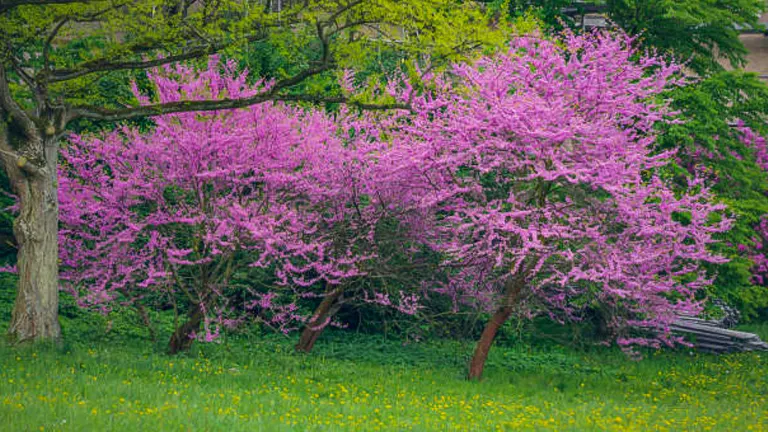
The Eastern Redbud (Cercis canadensis) is a remarkable member of the Fabaceae family, the same family as peas and beans. This association explains the tree’s unique ability to fix nitrogen in the soil, which enhances soil fertility and benefits surrounding plants. Typically, the Eastern Redbud grows to a height of 20 to 30 feet with a similar spread, forming a rounded canopy. Its early-spring bloom creates a kaleidoscope of pink, making it a standout in any landscape.
Key Characteristics
The Eastern Redbud is celebrated for its striking seasonal changes:
- Spring: Its most prominent feature is the profusion of pink blossoms that appear directly on the branches before the leaves emerge. This phenomenon, known as cauliflory, is relatively rare among temperate trees.
- Summer: The blossoms give way to heart-shaped leaves that start as reddish and mature to a rich green.
- Fall: In autumn, the leaves transition to a vibrant yellow, adding year-round visual interest.
- Winter: Even in winter, the tree’s dark, twisting branches create a striking silhouette against the snowy landscape.
These characteristics not only provide aesthetic appeal but also support various ecological functions, such as providing early nectar sources for pollinators like bees.
Varieties
Numerous cultivars of the Eastern Redbud have been developed to cater to diverse landscaping needs:
- ‘Forest Pansy’: This variety is notable for its vibrant purple leaves, which mature to a dark green, providing a striking contrast to its pink flowers.
- ‘Alba’: Distinguished by its pure white flowers, ‘Alba’ offers a stunning visual contrast and is perfect for creating a unique focal point in gardens.
- ‘Ruby Falls’: Known for its weeping form and deep red-purple foliage, ‘Ruby Falls’ creates a dramatic focal point and is ideal for smaller spaces or as a specimen plant.
Here’s a table summarizing some of the key features of these varieties:
| Variety | Leaf Color | Flower Color | Growth Habit | Unique Features |
|---|---|---|---|---|
| Forest Pansy | Purple to Dark Green | Pink | Upright, Spreading | Striking foliage color change |
| Alba | Green | White | Upright, Spreading | Unique white blossoms |
| Ruby Falls | Deep Red-Purple | Pink | Weeping | Dramatic form, suitable for small spaces |
Site Selection and Planting
Choosing the Right Location
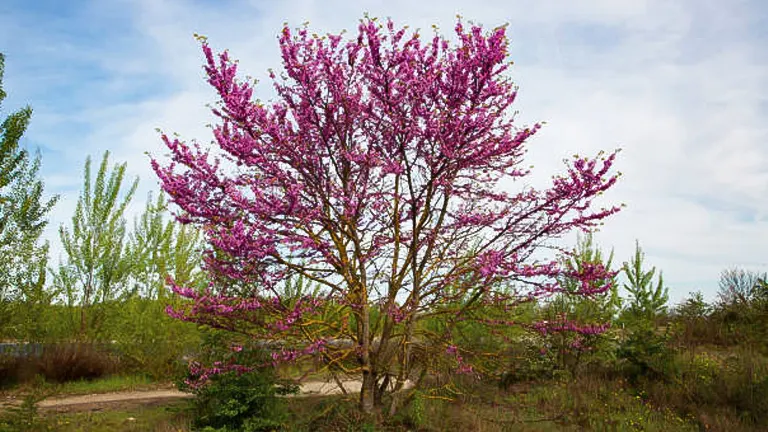
Selecting an optimal location is crucial for the health and display of an Eastern Redbud. These trees thrive under full to partial sunlight, with at least six hours of direct sunlight daily being ideal. Although they are adaptable to a range of conditions, Eastern Redbuds perform best in locations that provide some afternoon shade, particularly in hotter regions, to prevent stress during peak summer months. Avoid planting in low-lying areas where cold air or frost can settle, as Redbuds are susceptible to frost damage in early spring.
Soil Preparation
Eastern Redbuds are not particularly fussy about soil types, but they flourish in well-drained, rich soils with a neutral to slightly acidic pH (6.0 to 7.5). Testing the soil pH before planting is advisable, and adjustments can be made by adding lime to raise pH or sulfur to lower it. Enhancing the soil with organic compost improves drainage, aeration, and nutrient content, setting a strong foundation for the tree’s growth. Adding mycorrhizal fungi to the soil can also promote root health and nutrient absorption.
Planting Process
Planting should ideally be done during the cooler parts of spring or fall to avoid extreme temperatures affecting the young saplings. Follow these steps for effective planting:
- Digging the Hole: Dig a hole approximately twice as wide as the root ball and just as deep. This allows the roots to spread easily without forcing them too deep, which can lead to waterlogging issues.
- Preparing the Root Ball: Gently loosen the root ball to encourage outward growth. Trim any circling roots to prevent girdling.
- Planting: Place the tree in the hole with the root flare (where the roots meet the trunk) slightly above ground level. Fill the hole with a mixture of native soil and compost, pressing down lightly to remove air pockets.
- Watering: Water thoroughly to settle the soil around the roots. Create a small berm around the planting hole to hold water and direct it to the root zone.
- Mulching: Apply a 2-3 inch layer of mulch around the base, keeping it a few inches away from the trunk to prevent rot and discourage pests.
Eastern Redbud trees can be planted in various densities, depending on the purpose and space available. Here’s a guide to spacing:
| Density Type | Plant-to-Plant Distance | Row-to-Row Distance | Benefits |
|---|---|---|---|
| Medium-Density Orchard | 15 feet | 20 feet | Adequate space for canopy development, ease of maintenance, reduced disease risk |
| High-Density Orchard | 10 feet | 15 feet | Maximizes number of trees per acre, requires intensive management, increased yield in smaller spaces |
Watering and Nutritional Needs
Watering Schedule

Eastern Redbuds require consistent moisture to establish robust root systems, particularly during their first few years. Here’s a detailed guide to ensure optimal watering:
- Initial Establishment (First Year): Water deeply once a week, ensuring the soil is moist but not waterlogged. Allow the soil to dry slightly between waterings to encourage deep root growth.
- Young Trees (1-3 Years): Continue deep watering once a week, adjusting based on rainfall and soil drainage. During hot, dry periods, increase the frequency to twice a week if necessary.
- Mature Trees (3+ Years): Once established, Eastern Redbuds are relatively drought-tolerant. Water deeply every two to three weeks during dry spells. Reduce watering frequency in cooler, wetter months.
Deep-watering, which involves soaking the soil to a depth of 12-18 inches, is essential as it encourages roots to grow deeper, enhancing drought resistance.
| Tree Age | Watering Frequency | Notes |
|---|---|---|
| First Year | Once a week | Increase frequency in hot, dry conditions |
| 1-3 Years | Once a week (adjust as needed) | Ensure soil dries slightly between waterings |
| 3+ Years | Every 2-3 weeks during dry spells | Deep watering to 12-18 inches |
Fertilization
Proper fertilization is crucial for the health and flowering of Eastern Redbuds. Follow these guidelines to ensure your tree receives the nutrients it needs without over-fertilizing:
- Early Spring: Apply a balanced, slow-release fertilizer (10-10-10 NPK) at the beginning of the growing season. Use approximately 1 pound of fertilizer per inch of trunk diameter, spread evenly under the canopy but away from the trunk to prevent burn.
- Mid-Summer (Optional): If growth appears slow or the tree shows signs of nutrient deficiency (e.g., yellowing leaves), a second, lighter application can be made. Use a half-strength dose to avoid over-fertilization.
- Organic Alternatives: Compost and well-rotted manure are excellent organic alternatives to synthetic fertilizers. Apply a 2-3 inch layer of compost under the canopy in early spring to improve soil structure and provide a slow release of nutrients.
Avoid excessive fertilization, as it can lead to lush foliage growth at the expense of blooms and increase the tree’s susceptibility to pests and diseases.
Watering and Fertilization Guidelines
| Tree Age | Watering Frequency | Fertilization Timing | Notes |
|---|---|---|---|
| First Year | Once a week | Early Spring (balanced fertilizer) | Increase frequency in hot, dry conditions |
| 1-3 Years | Once a week (adjust as needed) | Early Spring, Mid-Summer (optional) | Ensure soil dries slightly between waterings |
| 3+ Years | Every 2-3 weeks during dry spells | Early Spring (organic alternatives) | Deep watering to 12-18 inches, avoid over-fertilization |
By incorporating these detailed insights and scientific data, this enhanced section provides a comprehensive and engaging understanding of the watering and nutritional needs of Eastern Redbud Trees, tailored for readers with a keen interest in scientific and practical gardening knowledge.
Optimal Planting Density and Arrangement
Plant-to-Plant and Row-to-Row Distance
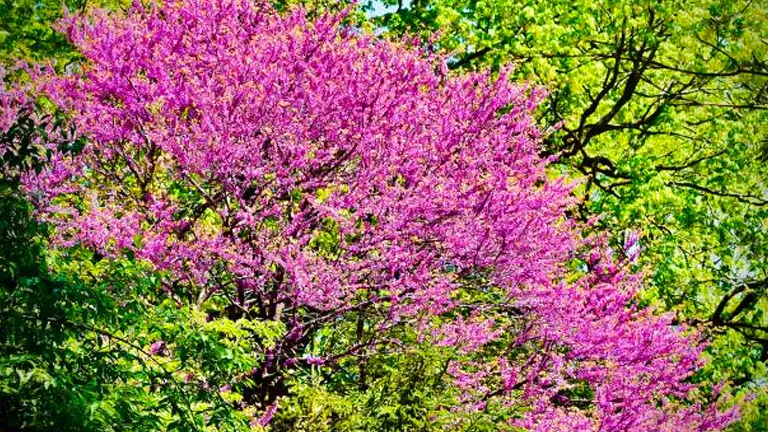
Proper spacing is crucial for the health and productivity of Eastern Redbud Trees, particularly in orchard setups. The following guidelines offer optimal spacing for different orchard densities:
- Medium-Density Orchards: In a medium-density arrangement, plant Eastern Redbud Trees approximately 15 feet apart. This spacing allows each tree to develop a full canopy, ensuring adequate light penetration and air circulation. Rows should be spaced about 20 feet apart. This arrangement provides sufficient room for maintenance activities and reduces disease pressure by enhancing airflow around the trees.
- High-Density Orchards: For high-density farming, trees should be planted closer together, about 10 feet apart. This configuration maximizes the number of trees per acre, leading to higher yield potential. However, this closer spacing necessitates more intensive management practices. Row spacing should be about 15 feet, which facilitates easier movement for pruning, harvesting, and other care activities.
Benefits and Challenges
Each planting density has its advantages and challenges:
- Medium-Density Orchards:
- Benefits: Easier maintenance, lower disease pressure, better light and air penetration.
- Challenges: Lower yield per acre compared to high-density planting.
- High-Density Orchards:
- Benefits: Higher yield per acre, efficient use of space.
- Challenges: Increased need for intensive management, higher risk of disease due to reduced airflow.
Optimal Planting Density Guidelines
| Orchard Type | Plant-to-Plant Distance | Row-to-Row Distance | Benefits | Challenges |
|---|---|---|---|---|
| Medium-Density Orchard | 15 feet | 20 feet | Easier maintenance, better light/air flow | Lower yield per acre |
| High-Density Orchard | 10 feet | 15 feet | Higher yield per acre, efficient space use | Requires intensive management, higher disease risk |
Additional Information: Pruning and Training Techniques
In both medium and high-density orchards, proper pruning and training techniques are essential to maintain tree health and maximize productivity:
- Formative Pruning: During the first few years, formative pruning helps establish a strong structure. Remove any competing leaders and ensure the development of a central leader with well-spaced lateral branches.
- Maintenance Pruning: Regular pruning to remove dead, diseased, or overcrowded branches improves air circulation and light penetration, reducing disease risk.
- Training Techniques: Use techniques such as espalier in high-density orchards to manage tree size and shape, promoting efficient space use and easier access for maintenance and harvesting.
Pruning and Maintenance
Pruning Techniques
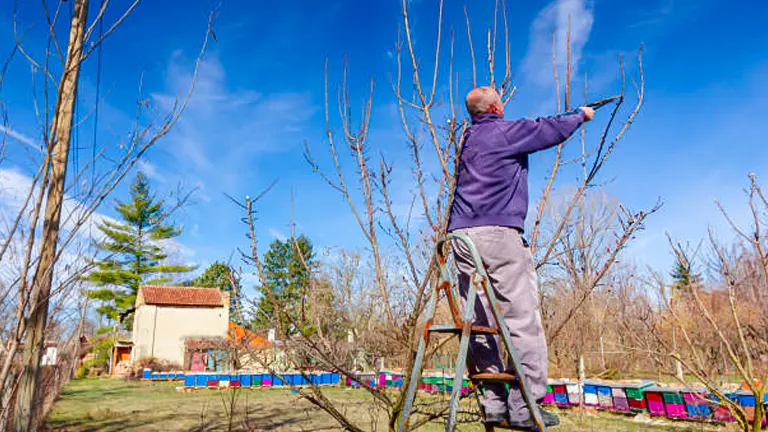
Pruning is vital not only to maintain the shape and aesthetic appeal of the Eastern Redbud but also to ensure its overall health and longevity. The best time to prune is in late winter or early spring before the new growth starts. This timing prevents the tree from losing too much sap, which is vital for its spring energy reserves. Here are key pruning techniques:
- Deadwood Removal: Focus on removing any dead or diseased branches. Deadwood not only detracts from the tree’s appearance but can also be a source of infection.
- Thinning: Thin out the interior branches to allow light and air to penetrate the foliage. This reduces the risk of fungal diseases and promotes healthy growth.
- Shaping: Shape the tree to enhance its natural form. This involves selectively pruning branches to maintain the tree’s structure and appearance.
- Rejuvenation Pruning: Occasionally remove older branches to encourage the growth of young, more vigorous branches. These younger branches will typically display more flowers.
Advanced Pruning Techniques
Training Pruning Techniques
- Formative Pruning: In the early years of the tree’s life, formative pruning is essential to establish a strong and productive structure. Select a central leader and a few well-spaced lateral branches to form the main framework of the tree. Remove any competing leaders and inward-growing branches to promote a healthy, outward-growing form.
- Maintenance Pruning: As the tree matures, focus on maintaining its structure, health, and appearance. This includes thinning out crowded areas, removing dead or diseased wood, and cutting back branches that are too long or that cross each other, which can lead to wounds and subsequent infections.
Pest and Disease Management
Eastern Redbuds are relatively hardy but can be affected by several pests and diseases. Common issues include:
- Canker: This disease causes areas of bark to die off and can severely damage or kill the tree if not managed. Pruning away affected areas and ensuring good tree health are effective preventive measures.
- Verticillium Wilt: A soil-borne fungus that can lead to the wilting and death of branches. Infected trees should be removed to prevent the spread of the fungus.
- Leaf Spot: Caused by fungi or bacteria, leaf spots can be minimized by ensuring leaves are not left wet for extended periods and by cleaning up fallen debris around the tree.
Proactive monitoring and maintenance can prevent these issues from becoming severe, preserving the tree’s health and display.
Seasonal Care
Spring Care
Spring is a crucial time for Eastern Redbuds as they exit dormancy and begin their growth cycle. Applying a layer of organic mulch around the base can help retain soil moisture and regulate soil temperature. Additionally, an early spring application of fertilizer can give the tree a healthy start to the season.
Summer Care
During the hot summer months, it’s important to maintain consistent soil moisture. Mulching proves invaluable here as well, helping to conserve water and suppress weeds. Monitoring for pests and diseases during this time will help catch any potential problems early.
Fall and Winter Care
As the tree prepares for dormancy in fall, reducing watering and stopping fertilization can help it harden off for the winter. Protecting young trees with tree wraps can prevent bark damage from cold and pests. Cleaning up fallen leaves and debris around the tree will minimize the risk of fungal diseases overwintering in the soil.
Common Challenges and Solutions
Eastern Redbud trees, while generally hardy, can encounter a few challenges that gardeners should be aware of:
- Cracking Bark: Sometimes caused by sudden changes in temperature or excessive sun exposure, bark cracking can be mitigated by situating the tree in a location that enjoys partial shade or by using a protective wrap during the winter months.
- Leaf Scorch: This condition, indicated by brown edges on leaves, often occurs due to insufficient moisture or overexposure to sun. Ensuring adequate watering during dry periods and choosing planting locations that offer some afternoon shade can prevent scorch.
- Pests: Common pests like scales and borers can threaten tree health. Regular inspections and timely treatment with appropriate pesticides or natural alternatives can control these issues.
By understanding these challenges and implementing proactive management strategies, gardeners can maintain the health and beauty of their Eastern Redbud trees.
Benefits of Growing Eastern Redbud Trees
Environmental Impact
Eastern Redbuds contribute significantly to local ecosystems. As a native species, they support biodiversity by providing habitat and food for various pollinators and birds during their flowering season. Furthermore, their ability to fix nitrogen in the soil enhances soil fertility and supports other plant life in the garden.
Aesthetic and Health Benefits
The visual appeal of Eastern Redbuds is undeniable. Their striking floral display provides an early sign of spring, bringing color and life to landscapes when most other plants are still dormant. Additionally, studies suggest that exposure to natural beauty, such as that offered by flowering trees, can improve mental health and wellbeing by reducing stress and increasing feelings of relaxation and happiness.
Related Post
- How to Build a Barn: A Step-by-Step Guide for Beginners
- How to Build a Sustainable Compost Bin: Easy and Eco-Friendly DIY
- How to Fertilize Bougainvillea: A Complete Guide for Stunning Blooms
- How to Fertilize Apple Trees: Essential Tips for a Bountiful Harvest
- How to Fertilize Lemon Trees: Secrets for Thriving Citrus
- How to Fertilize Avocado Tree: A Step-by-Step Guide for Lush Growth
- 10 Best Bow Saws to Buy in 2024: Top Picks for the Money
- Best Miter Saw For Beginners
- Top 10 Pruning Saws to Buy in 2024: Best for the Money
- 7 Best Pocket Chainsaw
Conclusion
Growing an Eastern Redbud Tree offers more than just aesthetic appeal; it brings a range of environmental benefits, making it a valuable addition to any garden. With the right care, these trees can thrive and transform any space into a vibrant display of nature’s beauty. By following the expert tips provided in this article, gardeners can ensure their Eastern Redbuds achieve stunning growth and contribute positively to their local environment.
FAQs
- What is the best time of year to plant an Eastern Redbud Tree?
The optimal planting times for Eastern Redbud Trees are during the spring and fall when the weather is cooler. This timing helps the trees establish roots without the stress of extreme heat or cold. - How much sunlight does an Eastern Redbud need?
Eastern Redbuds perform best in full sun to partial shade. Ideally, they should receive at least six hours of sunlight per day, though some afternoon shade can help protect them from the intense heat in warmer climates. - What type of soil is ideal for Eastern Redbuds?
Eastern Redbuds are adaptable to a variety of soil types but thrive in well-draining, moist soils with a neutral to slightly acidic pH. Amending the soil with organic compost can improve soil health and support robust growth. - How often should I water my Eastern Redbud Tree?
Newly planted Eastern Redbuds require regular watering to establish their roots, typically once a week. Mature trees can tolerate some drought but should be watered deeply during prolonged dry spells to maintain health and vigor. - When and how should I fertilize my Eastern Redbud?
Fertilize your Eastern Redbud in early spring with a balanced, slow-release fertilizer to promote healthy growth and flowering. Avoid over-fertilizing, as this can lead to more foliage growth at the expense of flowers. - What are the common pests and diseases that affect Eastern Redbuds, and how can I manage them?
Common issues include canker, verticillium wilt, and leaf spot. Managing these involves pruning out affected areas, ensuring proper soil drainage, and avoiding overhead watering to reduce moisture on leaves. Regularly inspecting and maintaining tree health can also prevent many pest and disease problems. - How should I prune an Eastern Redbud Tree?
Prune Eastern Redbuds in late winter or early spring before new growth starts. Focus on removing any dead or diseased branches, thinning the interior to allow light and air circulation, and shaping the tree to maintain its natural form. - Can Eastern Redbud Trees handle cold temperatures?
Eastern Redbuds are hardy in USDA zones 4 through 9, which means they can tolerate winter temperatures down to about -30°F (-34°C). In the colder parts of their range, providing some winter protection, such as mulching around the base, can help them survive harsh conditions.
We hope these expert tips inspire you to plant and nurture your own Eastern Redbud Tree. With just a bit of care, you can enjoy the stunning spring blooms and vibrant foliage that make this tree a beloved choice for any garden. Happy gardening!

Kristine Moore
Forestry AuthorI'm Kristine Moore, a seasoned garden landscaping professional with over 30 years of experience. My extensive career has been dedicated to transforming outdoor spaces into stunning, sustainable landscapes. With a deep understanding of horticulture, design principles, and environmental stewardship, I have become a respected figure in the field, known for creating harmonious, visually appealing, and eco-friendly gardens. My commitment to excellence and continuous learning in landscaping trends and techniques has solidified my reputation as an expert in garden design and implementation.
2 comments
Our Redbud has moss growing in some crevasses where big branches shoot out from the tree. Is this harmful ?




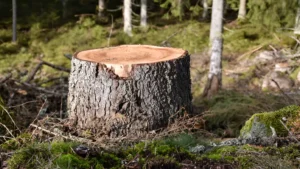








Can you plant the tree close to the house or will the roots cause problems with the house foundation or patio pavers? What is the optimal distance from the house?
Mike N.
August 17, 2024 10:18 pm